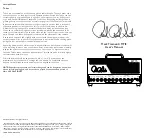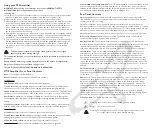
Using your PRS Amplifier
IMPORTANT: Before using your amplifier, refer to the IMPORTANT SAFETY
INSTRUCTIONS insert supplied with the product.
Powering Up:
1.
Make sure your speaker or speaker cabinet is connected to the correct speaker output
impedance jack with a high quality speaker cable. Do not use guitar cords.
2.
Make sure the power cord is connected to the correct grounded outlet.
3. Make sure there is at least 6 inches (150mm) of clearance around the amplifier to allow
for proper cooling. Never place the amplifier against a wall or other equipment, and
keep it clear of other heat sources, such as other amplifiers or stoves. Make sure there
are no flammable items, such as curtains, behind the amp. Do not drape items over
the amps that can prevent proper cooling. Do not set drinks or other liquids on top of
the amp that can spill into the amp.
4.
The amplifier is designed to be able to power up without the use of a Standby Switch.
It is OK to turn both switches on at the same time, or to leave the Standby Switch on
at all times. Use the Standby Switch to mute the amplifier when necessary.
5.
Turn the master volume down (lead channel), volume control down (clean channel) or
flip the Standby Switch off to mute the amp, plug in the guitar cable and any effects,
switch on the Standby, bring the volumes up and play some tunes. This amplifier
can produce very loud volumes so take care with this procedure to avoid volume
surprises.
This equipment is capable of very high sound pressure levels. Prolonged
exposure may cause hearing damage.
This equipment contains no user-serviceable parts. Refer all repairs to qualified service
personnel.
Ensure that the mains plug is easily accessible to allow the unit to be switched off.
Only connect this unit to an earthed supply socket.
THIS UNIT IS CLASS 1 CONSTRUCTION AND MUST BE EARTHED!
MT15 Amplifier Front Panel Controls
Input:
¼” Standard Mono Guitar Cable.
Channel Select:
Selects between Lead and Clean channels.
Lead Channel
Gain Control:
Adjust for preamp volume/distortion/saturation.
Treble Control:
Adjusts the high frequencies within the overall tone. This adjustment
allows the tone to become warmer at low settings and brighter at higher settings.
Middle Control:
Adjusts the midrange frequencies within the overall tone. This adjustment
allows the user to add fullness or body to the sound, or create a “scooped”, crisp sound.
Bass Control:
Adjusts the low frequencies within the overall tone. Lower settings will
sound tighter, especially with more gain and higher settings will add deep fullness and
thump.
Lead Channel Master:
Adjusts the overall loudness of the lead channel. Work this along
with the Gain Control to balance the volume between the Lead and Clean channels.
Clean Channel
Volume Control:
Increases the volume and gain of the clean channel.
Treble Control with Pull Boost:
Adjusts the high frequencies like the lead channel with an
added general gain boost of the clean channel frequencies when pulled.
Middle and Bass Controls:
Similar function to the lead channel controls.
Presence Control:
Adjusts power amp brightness on both channels globally.
Power On/Off and Standby Switches:
The MT15 was designed to not need a Standby Switch
as part of properly powering the amp on. However, as a convenience we have provided a
Standby Switch that effectively mutes the amp while it is still powered on. Use the switch
to mute the amp when changing guitars, effects, or between sets.
Rear Panel Controls
Mains Socket:
Always use the mains lead supplied. Your sales outlet can provide a
lead suitable for your country. Always disconnect the equipment from the mains and
ancillary units before moving.
Fuses:
This amplifier is equipped with multiple accessible and inaccessible fuses.
Replacement fuses must be of the same type and rating as indicated. Failure to comply
may result in permanent damage to the product, and/or create a safety hazard. Always
disconnect the equipment from the mains supply before replacing a fuse.
Mains Fuses:
These are located in the mains socket. There is one active and one spare.
B+ Fuse and Filament fuses:
These are located on the PCB board and should be
evaluated and replaced by a qualified technician.
Bias Jacks and Pot:
These jacks measure the power tube current draw in milliVolts.
1mV=1mA. Review the information on the back of this manual for guidance on replacing
tubes. Biasing and tube replacement should be performed only by a qualified
technician. Bias adjustments can be made with a jewelers Phillips head screwdriver.
Speaker Jacks:
These are the main outputs for your speaker cabinet(s). There are 3
total jacks to use. There are two 8 ohm jacks wired in parallel, and a single 16 ohm
jack. Determine beforehand what your total speaker loading will be and use the
appropriate jacks. Never use the 16 Ohm jack with the 8 Ohm jacks at the same time.
For two 16 ohm cabinets in parallel (creating and 8 Ohm load), plug each cabinet into
one of the two parallel 8 ohm jacks. Failure to correctly match the speaker load to the
appropriate output jacks can cause tube socket arcs, blown power tubes, or failure of
the amp.
Half Power Switch:
Selecting the half power setting changes the operation of the
power tubes from full-power pentode configuration to 8 watts in triode configuration.
Power down the amp when changing this switch or make the selection prior to turning
on the amp.
Effects Loop:
This amplifier features a series effects loop that is integral to the overall
sound of the amp. Connect the Send jack with a 1/4” mono instrument cable to the
input of your pedal(s). Connect your pedal(s) output to the Return jack also using
a 1/4” mono instrument cable. To minimize your cables picking up hum, arrange the
cables together for the first few feet away from the amp, and move them away from
the power transformer and mains power cable.
Footswitch Jack:
Connect the included PRS FSIM footswitch to control Channel
switching. Do not use other footswitches as they can possibly damage the amp. When
attached, the front panel Channel selector switch becomes inoperable.
Safety Symbols:
The following symbols mean:
Warning: read instructions to understand possible hazard
Danger: electrical shock hazard
Warning: This equipment is capable of very high sound pressure levels.
Prolonged exposure may cause hearing damage.



















